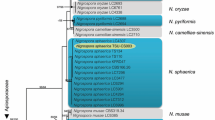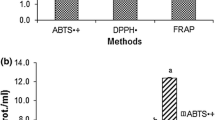Abstract
The current study indicates that octyl-β-D-glucopyranoside (OGP) as a detergent which has the ability to make the lipid layer stiff. OGP was subjected for toxicity studies and in vitro cytotoxicty assays on cancerous HeLa and non-cancerous myoblasts H9c2 cell lines. Test against aquatic organisms were carried out in Artemia salina and LC50 values were calculated. Hemolytic activity tested for blood bio-compalibity showed hemolysis rate of 10–16%, followed by thrombolytic activity to burst the clots in blood. Also, the samples showed good lysis when compared to the standard streptokinase. Furthermore, α-amylase activity has been carried out to check the inhibition of α-amylase by the OGP. Finally, antibacterial activity has been tested against four different pathogens and their MIC values have been calculated.









Similar content being viewed by others
References
Rather, M. Y., Mishra, S., & Chand, S. (2010). β-Glucosidase catalyzed synthesis of octyl-β-d-glucopyranoside using whole cells of Pichia etchellsii in micro aqueous media. Journal of Biotechnology, 150(4), 490–496. https://doi.org/10.1016/j.jbiotec.2010.09.933.
Newman, M. J., Foster, D. L., Wilson, T. H., & Kaback, H. R. (1981). Purification and reconstitution of functional lactose carrier from Escherichia coli. Journal of Biological Chemistry, 256(22), 11804–11808.
Vulfson, E. N., Patel, R., & Law, B. A. (1990). Alkyl-β-glucoside synthesis in a water-organic two-phase system. Biotechnology Letters, 12(6), 397–402. https://doi.org/10.1007/BF01024392.
Rosevear, P., VanAken, T., Baxter, J., & Ferguson-Miller, S. (1980). Alkyl glycoside detergents: a simpler synthesis and their effects on kinetic and physical properties of cytochrome c oxidase. Biochemistry, 19(17), 4108–4115. https://doi.org/10.1021/bi00558a032.
Lopez, O., Cocera, M., Parra, J. L., & De La Maza, A. (2001). Influence of the alkyl chain length of alkyl glucosides on their ability to solubilize phosphatidylcholine liposomes. Colloids and surfaces A: physicochemical and engineering aspects, 193(1-3), 221–229. https://doi.org/10.1016/S0927-7757(01)00698-7.
Wegener, M., & Von Rybinski, W. (2001). Surfactant systems for microemulsions and their importance for applications. Tenside, Surfactants, Detergents, 38, 24–29.
Krylova, O. O., Jahnke, N., & Keller, S. (2010). Membrane solubilisation and reconstitution by octylglucoside: comparison of synthetic lipid and natural lipid extract by isothermal titration calorimetry. Biophysical Chemistry, 150(1-3), 105–111. https://doi.org/10.1016/j.bpc.2010.03.013.
Mahata, S., Pandey, A., Shukla, S., Tyagi, A., Husain, S. A., Das, B. C., & Bharti, A. C. (2013). Anticancer activity of Phyllanthus emblica Linn.(Indian gooseberry): inhibition of transcription factor AP-1 and HPV gene expression in cervical cancer cells. Nutrition and Cancer, 65(sup1), 88–97. https://doi.org/10.1080/01635581.2013.785008.
Yin, Y., Guan, Y., Duan, J., Wei, G., Zhu, Y., Quan, W., & Wen, A. (2013). Cardioprotective effect of Danshensu against myocardial ischemia/reperfusion injury and inhibits apoptosis of H9c2 cardiomyocytes via Akt and ERK1/2 phosphorylation. European Journal of Pharmacology, 699(1-3), 219–226. https://doi.org/10.1016/j.ejphar.2012.11.005.
Arulvasu, C., Jennifer, S. M., Prabhu, D., & Chandhirasekar, D. (2014). Toxicity effect of silver nanoparticles in brine shrimp Artemia. The Scientific World Journal, 2014, 1–10. https://doi.org/10.1155/2014/256919.
Krishnaraju, A. V., Rao, T. V., Sundararaju, D., Vanisree, M., Tsay, H. S., & Subbaraju, G. V. (2005). Assessment of bioactivity of Indian medicinal plants using brine shrimp (Artemia salina) lethality assay. International Journal of Applied Science and Engineering, 3, 125–134.
Svensson, B. M., Mathiasson, L., Mårtensson, L., & Bergström, S. (2005). Artemia salina as test organism for assessment of acute toxicity of leachate water from landfills. Environmental Monitoring and Assessment, 102(1-3), 309–321. https://doi.org/10.1007/s10661-005-6029-z.
Vinjamuri, S., Shanker, D., Ramesh, R. S., & Nagarajan, S. (2015). In vitro evaluation of hemolytic activity and cell viability assay of hexanoic extracts of Bridelia ferruginea benth. World Journal of Pharmacy and Pharmaceutical Sciences, 4, 1263–1268.
Seeman, P. (1972). The membrane actions of anesthetics and tranquilizers. Pharmacological Reviews, 24(4), 583–655.
Bae, J., Choi, E. H., & Pan, J. G. (2011). Efficient synthesis of octyl-β-D-galactopyranoside by Bacillus spore-displayed β-galactosidase using an amphiphilic 1, 2-dimethoxyethane co-solvent. Enzyme and Microbial Technology, 48(3), 232–238. https://doi.org/10.1016/j.enzmictec.2010.11.002.
Rahman, M. A., Sultana, R., Emran, T. B., Islam, M. S., Rahman, M. A., Chakma, J. S., & Hasan, C. M. M. (2013). Effects of organic extracts of six Bangladeshi plants on in vitro thrombolysis and cytotoxicity. BMC Complementary and Alternative Medicine, 13(1), 25. https://doi.org/10.1186/1472-6882-13-25.
Feng, J., Yang, X. W., & Wang, R. F. (2011). Bio-assay guided isolation and identification of α-glucosidase inhibitors from the leaves of Aquilaria sinensis. Phytochemistry, 72(2-3), 242–247. https://doi.org/10.1016/j.phytochem.2010.11.025.
Sancheti, S., & Seo, S. (2009). Chaenomeles sinensis: a potent α-and β-glucosidase inhibitor. American Journal of Pharmacology and Toxicology, 4, 8–11.
Liu, Y. C., Lin, W. Y., Jhang, Y. R., Huang, S. H., Wu, C. P., & Wu, H. T. (2011). Efficiency of DNA transfection of rat heart myoblast cells H9c2 (2-1) by either polyethyleneimine or electroporation. Applied Biochemistry and Biotechnology, 164(7), 1172–1182. https://doi.org/10.1007/s12010-011-9203-5.
Singh, B., Kaur, T., Kaur, S., Manhas, R. K., & Kaur, A. (2015). An alpha-glucosidase inhibitor from an endophytic Cladosporium sp. with potential as a biocontrol agent. Applied Biochemistry and Biotechnology, 175(4), 2020–2034. https://doi.org/10.1007/s12010-014-1325-0.
Nickavar, B., & Mosazadeh, G. (2010). Influence of three Morus species extracts on 훼-amylase activity. Iranian Journal of Pharmaceutical Research, 8, 115–119.
Gao, H., Huang, Y. N., Gao, B., Li, P., Inagaki, C., & Kawabata, J. (2008). Inhibitory effect on α-glucosidase by Adhatoda vasica Nees. Food Chemistry, 108(3), 965–972. https://doi.org/10.1016/j.foodchem.2007.12.002.
Santimone, M., Koukiekolo, R., Moreau, Y., Le Berre, V., Rougé, P., Marchis-Mouren, G., & Desseaux, V. (2004). Porcine pancreatic α-amylase inhibition by the kidney bean (Phaseolus vulgaris) inhibitor (α-AI1) and structural changes in the α-amylase inhibitor complex. Biochimica et Biophysica Acta (BBA)-Proteins and Proteomics, 1696, 181–190.
Malagoli, D. (2007). A full-length protocol to test hemolytic activity of palytoxin on human erythrocytes. Invertebrate Survival Journal, 4, 92–94.
Sherwani, S. K., Khan, M. M., Zubair, A., Shah, M. A., & Kazmi, S. U. (2013). Evaluation of in vitro thrombolytic activity of Bougainvillea spectabilis leaf extract. International Journal of Pharmaceutical Sciences Review and Research, 21, 6–9.
Unnikrishnan, P. S., Suthindhiran, K., & Jayasri, M. A. (2014). Inhibitory potential of Turbinaria ornata against key metabolic enzymes linked to diabetes. BioMed Research International, 2014, 1–10. https://doi.org/10.1155/2014/783895.
Tharachand, C., Selvaraj, C. I., & Abraham, Z. (2015). Comparative evaluation of anthelmintic and antibacterial activities in leaves and fruits of Garcinia cambogia (Gaertn.) desr. and Garcinia indica (Dupetit-Thouars) choisy. Brazilian Archives of Biology and Technology, 58(3), 379–386. https://doi.org/10.1590/S1516-8913201500062.
Author information
Authors and Affiliations
Corresponding authors
Ethics declarations
Conflicts of Interest
The authors declare that they have no conflict of interest.
Rights and permissions
About this article
Cite this article
Dinesh, M., Deepika, S., HarishKumar, R. et al. Evaluation of Octyl-β-D-Glucopyranoside (OGP) for Cytotoxic, Hemolytic, Thrombolytic, and Antibacterial Activity. Appl Biochem Biotechnol 185, 450–463 (2018). https://doi.org/10.1007/s12010-017-2661-7
Received:
Accepted:
Published:
Issue Date:
DOI: https://doi.org/10.1007/s12010-017-2661-7




